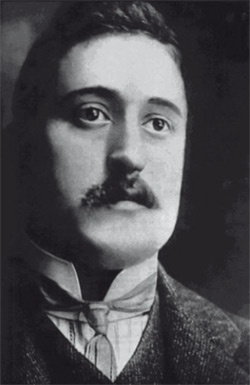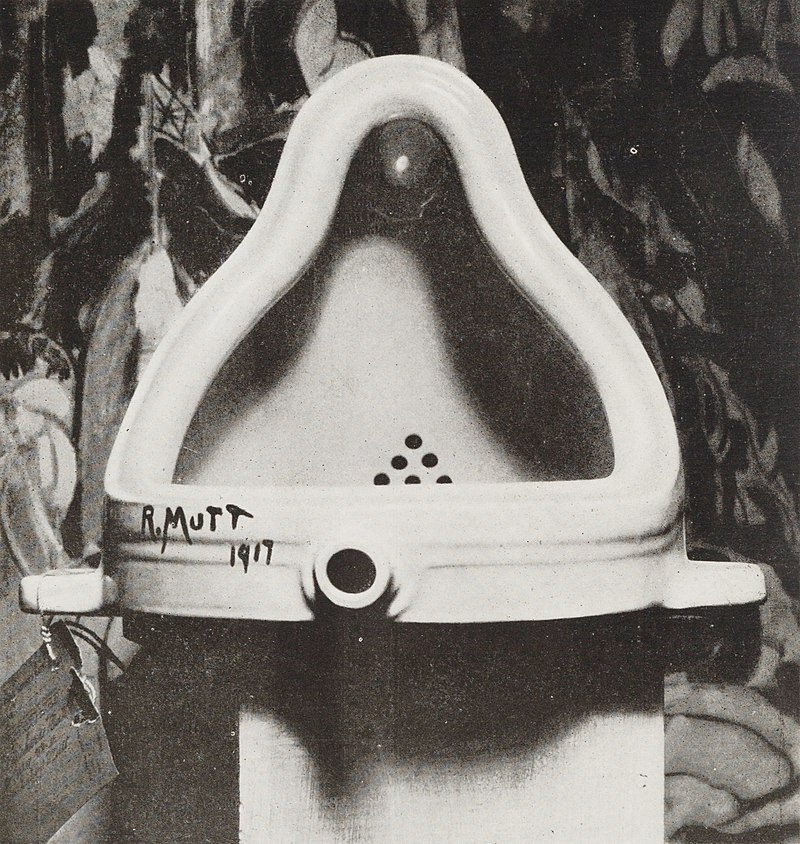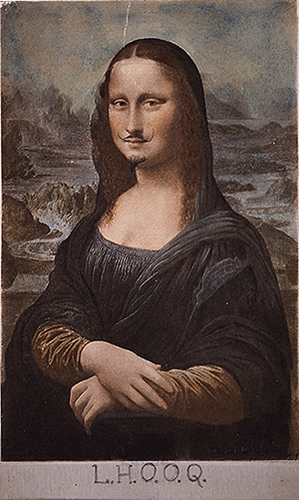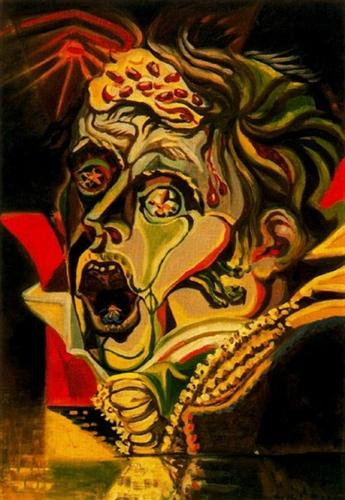Surrealism is anything weird and wonderful it occurred in the early 1920's as a broad intellectual movement not just an art movement.It continued in the 1960's between the first world war and the second world was when it was most productive.surrealism also continues to influence many art forms today.
Sur-realism:- super-realism truth beyond real.
It was coined by the French writer Guillaume Apollinaire and appropriated by Andre Breton.
Guillaume Apollinaire:-
He is considered one of the foremost poets of the early 20th century, as well as one of the forefathers of surrealism. He is credited with coining the word "surrealism", and writing one of the earliest works described as surrealist, the play The Breasts of Tiresias.Two years after being wounded in World War I, he died in the Spanish flu pandemic of 1918 at age 38.

Andre Breton:-
He was a French writer and poet. He is known best as the founder of Surrealism. His writings include the first Surrealist Manifesto of 1924, in which he defined surrealism as "pure psychic automatism"

Why did surrealism happen?
It was a development of Dada. It was less anarchic movement than Dada.
It responded to psychoanalytical investigation by Sigmund Freud.
Influences:-
Giorgio De Chirico:- He was an Italian artist years before world war I, he founded the scuola metafisica art movement, which profoundly influenced the surrealists. He frequently revisiting the metaphysical themes of his earlier work.
The Uncertainty of the Poet 1913

Marcel Duchamp - He was a French-American painter, sculptor, chess player, and writer whose work is associated with Dadaism and conceptual art,
The Fountain:- It was voted as the iconic image of the 20th century and the most influential., Fountain was rejected by the committee, even though the rules stated that all works would be accepted from artists who paid the fee. Fountain was displayed and photographed at Alfred Stieglitz's studio, and the photo published in The Blind Man, but the original has been lost.

Bicycle wheel- It was known as the first kinetic sculptor consisting of a bicycle fork with front wheel mounted upside-down on a wooden stool.The original from 1913 was lost, and Duchamp recreated the sculpture in 1951it came to life when the wheel was spun.

L.H.O.O.Q-1919:- Is a cheap postcard-sized reproduction of the Mona Lisa,upon which Duchamp drew a mustache and a goatee. The "readymade" done in 1919, is one of the most well known act of degrading a famous work of art. The title when pronounced in French, puns the frase "Elle a chaud au cul", translating colloquially in "She has a hot ass".

Rrose selavy,photogfraphy- man ray (1921) "Rrose Sélavy", also spelled Rose Sélavy, was one of Duchamp's pseudonyms. Rrose Sélavy and the other pseudonyms Duchamp used may be read as a comment on the fallacy of romanticizing the conscious individuality or subjectivity of the artist.

Joan Miro 1893- Automatic art ,was a Catalan Spanish painter, sculptor, and ceramicist born in Barcelona. A museum dedicated to his work, the Fundació Joan Miró, was established in his native city of Barcelona in 1975. in his work he used a language of symbols which reflected his personal vision.

He influenced Jon bugerman: From Pepsi cans to his own iPhone app, Inkstrumental, Jon Bugerman is a man on a mission to make the world a far more colourful, wibbly sort of place. Cartoonist, designer, sculptor, street artist, mole lover, rapper even - we caught up with the mixed-media doodlemeitser.

Salvador Dali- Spanish master himself mainly focused on dreams, Well, Dali had some tricks for making himself more creative. One involved a tin plate and spoon. Dali would sit in a chair holding the spoon above the plate and doze off. As he fell asleep, the spoon would drop onto the plate, making a noise loud enough to wake the artist in time to jot down the surreal images he saw in his dreams

The persistence of memory:-
It is one of his most recognizable works.First shown at the Julien Levy Gallery in 1932, It is widely recognized and frequently referenced in popular culture.

The Uncertainty of the Poet 1913

Marcel Duchamp - He was a French-American painter, sculptor, chess player, and writer whose work is associated with Dadaism and conceptual art,
The Fountain:- It was voted as the iconic image of the 20th century and the most influential., Fountain was rejected by the committee, even though the rules stated that all works would be accepted from artists who paid the fee. Fountain was displayed and photographed at Alfred Stieglitz's studio, and the photo published in The Blind Man, but the original has been lost.

Bicycle wheel- It was known as the first kinetic sculptor consisting of a bicycle fork with front wheel mounted upside-down on a wooden stool.The original from 1913 was lost, and Duchamp recreated the sculpture in 1951it came to life when the wheel was spun.

L.H.O.O.Q-1919:- Is a cheap postcard-sized reproduction of the Mona Lisa,upon which Duchamp drew a mustache and a goatee. The "readymade" done in 1919, is one of the most well known act of degrading a famous work of art. The title when pronounced in French, puns the frase "Elle a chaud au cul", translating colloquially in "She has a hot ass".

Rrose selavy,photogfraphy- man ray (1921) "Rrose Sélavy", also spelled Rose Sélavy, was one of Duchamp's pseudonyms. Rrose Sélavy and the other pseudonyms Duchamp used may be read as a comment on the fallacy of romanticizing the conscious individuality or subjectivity of the artist.

Joan Miro 1893- Automatic art ,was a Catalan Spanish painter, sculptor, and ceramicist born in Barcelona. A museum dedicated to his work, the Fundació Joan Miró, was established in his native city of Barcelona in 1975. in his work he used a language of symbols which reflected his personal vision.

He influenced Jon bugerman: From Pepsi cans to his own iPhone app, Inkstrumental, Jon Bugerman is a man on a mission to make the world a far more colourful, wibbly sort of place. Cartoonist, designer, sculptor, street artist, mole lover, rapper even - we caught up with the mixed-media doodlemeitser.
Salvador Dali- Spanish master himself mainly focused on dreams, Well, Dali had some tricks for making himself more creative. One involved a tin plate and spoon. Dali would sit in a chair holding the spoon above the plate and doze off. As he fell asleep, the spoon would drop onto the plate, making a noise loud enough to wake the artist in time to jot down the surreal images he saw in his dreams
The persistence of memory:-
It is one of his most recognizable works.First shown at the Julien Levy Gallery in 1932, It is widely recognized and frequently referenced in popular culture.

kurt Schwitters 1887-1948:- Schwitters worked in several genres and media, including Dada, Constructivism, Surrealism, poetry, sound, painting, sculpture, graphic design, typography, and what came to be known as installation art. He is most famous for his collages, called Merz Pictures.
The Merz barn-
In 1941, after release from internment on the Isle of Man, Schwitters moved to London until the end of the war. In 1945 he moved with his English partner Edith Thomas to live in Ambleside in the Lake District. There, largely unknown and unrecognised, he struggled to earn a living by painting portraits of local people and Lake District landscapes.

Here's a video about The Merz barn
Andre Masson 1896-1987- He was a French artist who's main focus was automatic painting and drawing.
Portrait of the poet Kleist:-

Max Ernst- He was a German painter, sculptor, graphic artist, and poet. A prolific artist, Ernst was a primary pioneer of the Dada movement and Surrealism.
Celebes 1921-Ernst has transformed into a sinister mechanical monster. Ernst often re-used found images, and either added or removed elements in order to create new realities, all the more disturbing for being drawn.

CLAM TREE, WOODEN BIRD AND BIG-EYED FISH:-
In 1925, Max Ernst for the first time laid paper on the boards of a wooden floor and rubbed their surface structure onto it with the help of a pencil. The patterns and forms that thus became visible turned into independent and unique landscapes, objects and creatures that had to be found and, if necessary, highlighted with a pencil. This is how Max Ernst developed a technique called “frottage”, which he would often make use of later on and also adapt to oil painting.

Rene magrittte- His work is humerous because they don't make sence, and there not understandable. As a Belgian surrealist artist. He became well known for a number of witty and thought-provoking images that fall under the umbrella of surrealism. His work is known for challenging observers' preconditioned perceptions of reality.
“Ceci n’est pas une pipe.” (This is not a pipe):-What this is telling us is indeed that: no, this isn't a pipe. This is the image of a pipe. A representation of reality, an idea. The representation cannot be equal to reality because it is an interpretation of it. We are never totally objective and can never show reality in its totality.



No comments:
Post a Comment